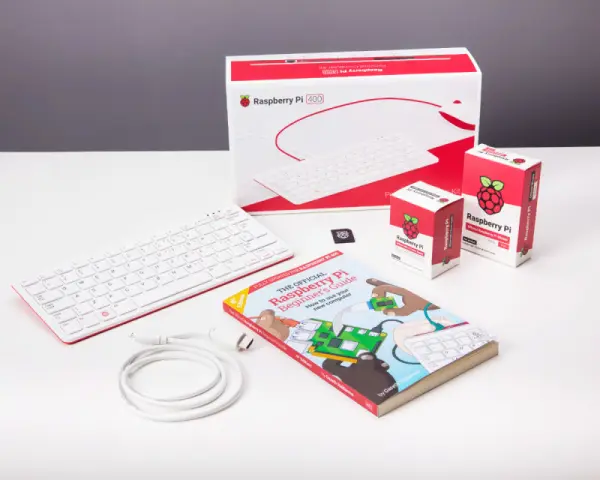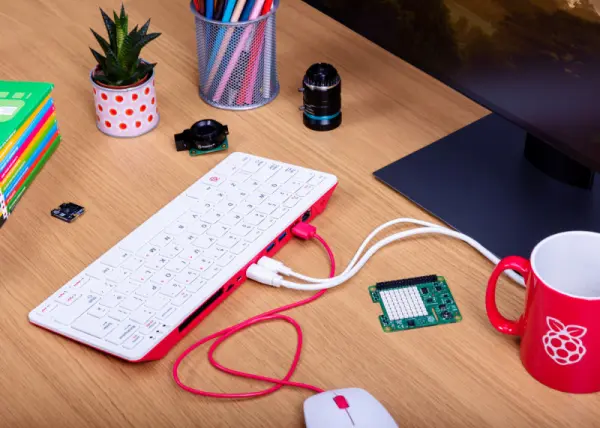When does a keyboard cease to be just a keyboard? When it encompasses an entire personal computer. Raspberry Pi 400 takes us back to the early era of personal computing, where individuals, be it bedroom programmers or office workers, connected all-in-one keyboards directly to their TVs and monitors. These keyboards served as the hub for a multitude of activities ranging from gaming to coding.
Raspberry Pi 400 introduces a notable increase in speed compared to the Raspberry Pi 4, thanks to an ingenious passive cooling mechanism that allows for a processor boost up to 1.8GHz. Join us as we explore the remarkable advancements of the latest Raspberry Pi model, which stands out as the most impressive one to date.
Raspberry PI 400 specifications
Price: £65 / $70 for Raspberry Pi 400 and £93.00 / $100 for Raspberry Pi 400 Personal Computer Kit
System-on-Chip (SoC): Broadcom BCM2711C0 quad-core A72 (ARMv8-A) 64-bit processor running at 1.8GHz
Graphics Processing Unit (GPU): Broadcom VideoCore VI
Random Access Memory (RAM): 4GB LPDDR4 SDRAM
Networking: 2.4 GHz and 5 GHz 802.11b/g/n/ac wireless LAN, gigabit Ethernet
Bluetooth: Bluetooth 5.0, Bluetooth Low Energy (BLE)
General Purpose Input/Output (GPIO): 40-pin GPIO header, pre-installed
Storage: microSD
Ports: 1× USB Type-C power input, 2× micro-HDMI 2.0, 1× USB 2.0, 2× USB 3.0, 1× RJ45 Ethernet, 1× Kensington locking slot
Cooling: Integrated passive heatsink
Dimensions: 286mm × 122mm × 23.7mm, weighing 385g
Where to buy Raspberry Pi 400
Here are some notable resellers of Raspberry Pi 400:
– The Pi Hut
– Pimoroni
– pi3g
– Reichelt
– Pi Australia
– Cytron
For a comprehensive list of Raspberry Pi 400 resellers, please click here.
Raspberry Pi 400 Personal Computer Kit
Raspberry Pi 400 is available for purchase either as a standalone product or as part of a comprehensive Personal Computer Kit that includes all the necessary accessories. When you open the package, you will find the following items:
– Raspberry Pi 400 computer
– USB mouse
– Power supply
– microSD card
– HDMI cable
– Beginner's Guide book
Meet Raspberry PI 400
At first glance, Raspberry Pi 400 may appear strikingly similar to the Raspberry Pi keyboard and hub. It boasts the same excellent keyboard with a remarkable resemblance.
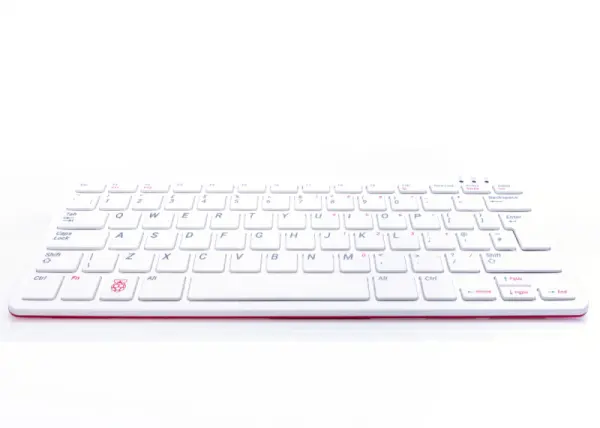
Around the back of Raspberry Pi 400
However, the backside of Raspberry Pi 400 reveals a distinct narrative, showcasing a multitude of sockets and connectors.
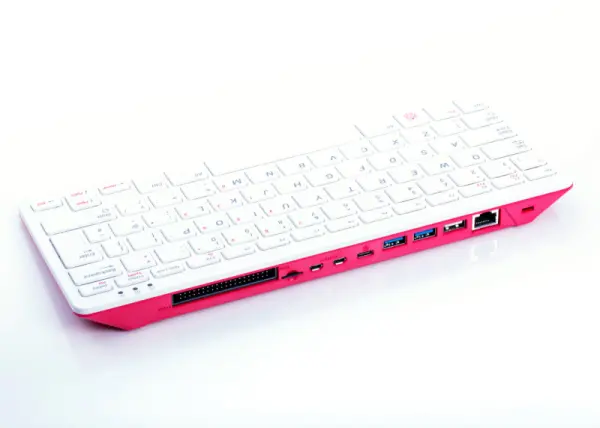
Utilizing the 40-pin GPIO header, Raspberry Pi 400 establishes connections with various electronic devices, enabling users to engage in electronic experimentation and coding. Upon closer inspection, you will notice PIN1 and PIN40 markings imprinted on the case, indicating the locations of the first and last pins.
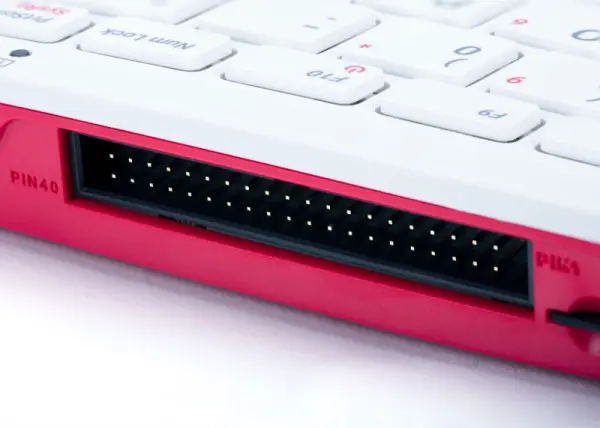
Using HAT hardware with Raspberry Pi 400
Raspberry Pi 400 shares the identical 40-pin GPIO header found in all current Raspberry Pi models, albeit now situated on the rear side of the case.
When connecting HAT (Hardware Attached on Top) devices to the 40-pin GPIO header, they will be oriented in a backward and downward manner. To address this, a ribbon cable can be utilized to extend the GPIO pins, allowing most devices to connect to Raspberry Pi 400 with the pins facing upward. Retailers like The Pi Hut offer ribbon cables, typically priced around £3.
For this particular setup, we are using a 40 Pin GPIO Ribbon Cable – Rainbow 150mm available at The Pi Hut for £3.
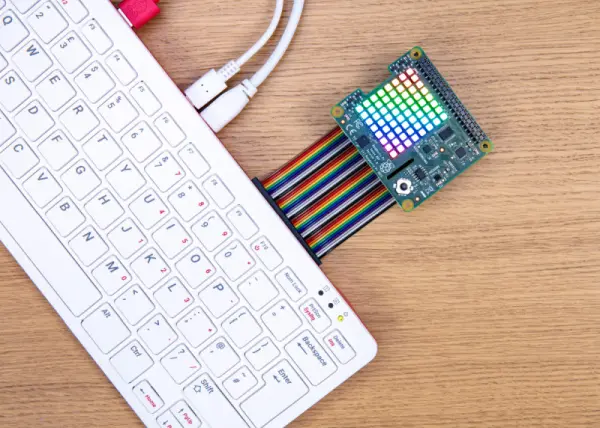
Raspberry Pi 400 sockets and connections
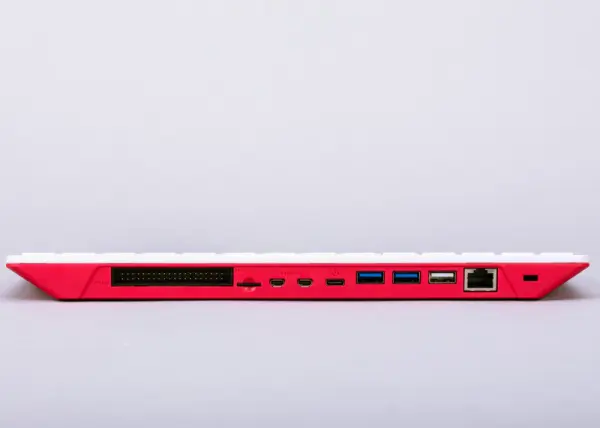
microSD socket
The primary storage for Raspberry Pi 400 is facilitated through a push-click microSD socket. It serves as the main drive, and the package includes a 16GB microSD card already equipped with pre-installed Raspberry Pi OS. To commence using Raspberry Pi 400, simply ensure that the microSD card is correctly inserted and power up the device.
2x micro HDMI
To establish connections between Raspberry Pi 400 and a maximum of two 4K monitors, two micro HDMI connectors are employed. Raspberry Pi emphasizes their satisfaction with the micro HDMI connector form factor and explains that full-size connectors would not allow for dual display support. As part of the Raspberry Pi 400 Personal Computer Kit, a micro HDMI to HDMI cable is provided to facilitate these connections.
USB-C power
Raspberry Pi 400 draws its power through the USB-C Power connection, utilizing the Raspberry Pi 15.3W USB-C Power Supply that is conveniently provided as part of the Raspberry Pi 400 Personal Computer Kit.
USB 3.0
For devices that demand high-speed data transfer, such as external storage drives, two USB 3.0 sockets are available on Raspberry Pi 400 to establish connections.
USB-A 2.0
Raspberry Pi 400 includes a lone USB 2.0 socket, which is typically utilized for connecting the included mouse.
Gigabit Ethernet
The inclusion of Gigabit Ethernet on Raspberry Pi 400 ensures a speedy and direct network connection.
Kensington lock socket
To enhance security, Raspberry Pi 400 is equipped with a security lock socket that allows you to firmly fasten it to a table or other surfaces.
Inside Raspberry Pi 400
Raspberry Pi 400 cleverly integrates all its components within the keyboard itself, minimizing clutter and streamlining the setup process. In fact, if you opt for the bundled version, it conveniently includes a pre-installed Raspberry Pi OS microSD card, allowing you to start using the device promptly and effortlessly.
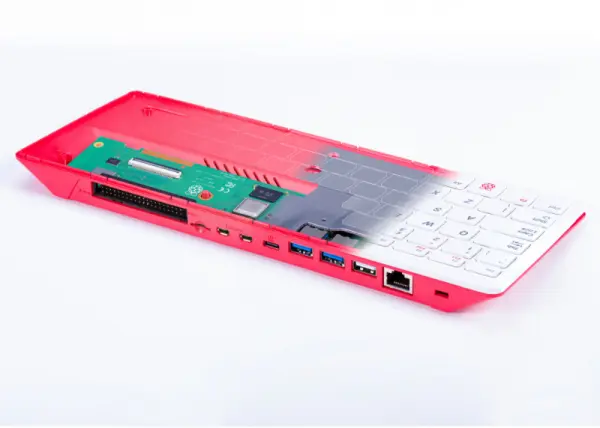
The underside of the case for Raspberry Pi 400 features a screw-less design, with two ventilated sections that allow the built-in heatsink cooling system to function optimally. Additionally, a QR Code containing the serial number is included, serving as a convenient reference in case support is required.
Within Raspberry Pi 400, the custom heatsink occupies a significant portion of the casing. It is connected to the system-on-chip using a thermal pad, working silently to prevent thermal throttling and enabling the processor to operate at an enhanced base speed of 1.8GHz.
Beneath the heatsink, the layout of the printed circuit board in Raspberry Pi 400 differs notably from previous models. The board is elongated and slender, accommodating the Ethernet hardware on the left side, followed by the USB and HDMI ports, the central silver system-on-chip, the GPIO and keyboard connectors, and concluding on the right side with the wireless LAN and Bluetooth radio components.
Opening Raspberry Pi 400
Exercise caution when opening your Raspberry Pi 400 as it does not have any screws. Instead, it is held together by clips on all four sides of the body. To separate the two halves, gently insert a spudger or plectrum between them and slide it until you feel a clip, then apply pressure to release it. Repeat this process for all the clips until the two halves are separated. To detach the heatsink, you will need to remove the four screws.
Benchmarking Raspberry Pi 400
With an additional 300MHz of clock speed, Raspberry Pi 400 proves itself to be a highly capable device. Not only does it introduce a completely new form factor as Raspberry Pi's first integrated design, but it also stands out as the fastest Raspberry Pi model ever released. Its substantial metal heatsink, spanning almost the entire width of the casing, contributes to the system-on-chip's clock speed of 1.8GHz— an improvement from Raspberry Pi 4's 1.5GHz.
The enhanced speed is noticeable in various tasks, ranging from web browsing and image editing to running Python programs. Importantly, this speed boost does not compromise compatibility. Raspberry Pi 400 remains fully compatible with all software and operating systems that work on Raspberry Pi 4, as well as older models.
Additionally, Raspberry Pi 400 demonstrates power efficiency. While the extra 300MHz results in higher power consumption compared to Raspberry Pi 4 during intensive workloads, it also completes tasks more swiftly. Moreover, the elimination of the need for an external USB keyboard reduces power usage during idle periods.
For most use-cases, Raspberry Pi 400 emerges as the top choice. However, those engaged in embedded projects may still prefer the more compact Raspberry Pi 4 model, which offers features like the Display Serial Interface (DSI) and Camera Serial Interface (CSI) ports, as well as Power over Ethernet (PoE) capabilities.
Raspberry Pi 400 benchmark testing: Linpack (higher is better)
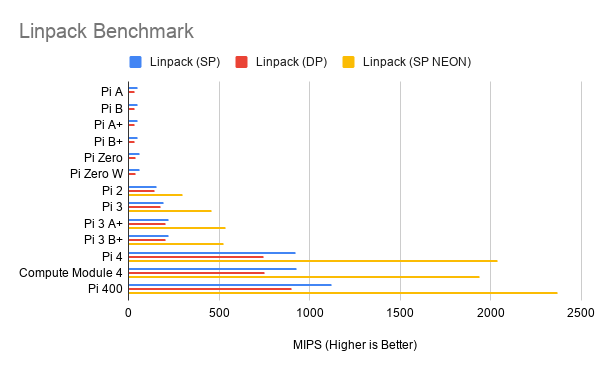
Originally developed for supercomputers, this synthetic benchmark – ported to Raspberry Pi OS by Roy Longbottom – offers a look at best-case performance gains between models. Three versions of the benchmark are compared: Single Precision (SP), Double Precision (DP), and a Single Precision variant which uses the accelerated Arm NEON instructions available since Raspberry Pi 2.

Find comprehensive information about Raspberry Pi 400 in Issue #100 of The MagPi magazine, available for purchase from 26 November 2020. This edition offers an extensive interview with Eben Upton, CEO of Raspberry Pi and co-creator of the Raspberry Pi computer, along with Simon Martin, Senior Principal Hardware Engineer at Raspberry Pi and designer of Raspberry Pi 400. Additionally, you'll discover detailed benchmarks and thermal testing of Raspberry Pi 400. Don't miss out on any future issues by subscribing to The MagPi—click here to subscribe and stay up-to-date.



